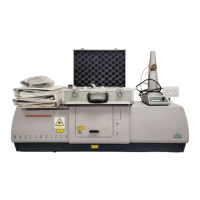'
Note
.
The range lens is actually part of the receiver assembly but has been
included here for clarity.
%
Caution!
See “Choosing a range lens” in chapter 4.
à Sample cell
The sample to be measured is passed through the analyser beam by propelling the
sample through a cell. Malvern make various forms of cell to cope with different
types of material. One exception to using a cell is the case of spray measurements
where an aerosol is sprayed directly though the analyser beam.
There are three types of cell available:
Stirred cell. This is the simplest form of cell and is designed for samples
dispersed in a liquid. The sample and its liquid dispersant are placed into
the cell and the solution is kept in suspension by magnetically rotating a
stirrer bead within the cell.
Flow cell. A flow cell is also used for samples dispersed in a liquid. The
sample and dispersant are kept in suspension by an external accessory that
then pumps the solution through the flow cell.
Air cell. An air cell is used when measuring dry powders. The sample is
blown or dropped through the air cell by an external accessory.
Ä Cell pipe connectors
If a flow cell is used then the connecting pipes from the cell to the sample
preparation accessory are passed through the covers via the pipe connectors.
Å Removable accessory panels
Certain accessories, e.g. the Free Fall Dry Powder Feeder or the air cells, protrude
outside the sample area cover. To facilitate this there are three removable
accessory panels where one or more are removed to fit the accessory.
The optical unit will not operate correctly if more than one range lens is
mounted at any one time.
CHAPTER 2
Getting Started
Page 2.6
MAN 0101

